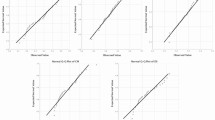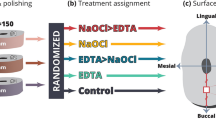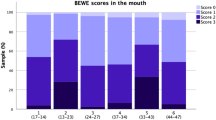Key Points
-
Patients are very aware of rough restorations.
-
Little research has been carried out on the degree to which patients can detect differences in roughness.
-
This study shows that previous figures for surface roughness values were much too high.
Abstract
Objective To determine a threshold of detection value for surface roughness of restorations by patients using their tongue.
Method Samples of composite resin were finished with differing grades of abrasive. The surface roughness (Ra) was measured and representative scanning electro-micrographs taken. These were compared with labial enamel. Twenty-five volunteers were asked to rank them in order of perceived roughness using the tip of their tongue.
Results These showed that the 60% of volunteers were able to rank the specimens correctly, and were able to distinguish differences in roughness values from between 0.25 and 0.50 μm. This range encompasses that of natural enamel.
Conclusions The subjects were able to distinguish lower roughness values than have previously been reported. It is concluded that when finishing restorations the surface should have a maximum roughness 0.50 μm if it is not to be detected by the patient.
Similar content being viewed by others
Main
One of the prime reasons to finish and polish restorations is for patient comfort. By that it is assumed that the filling does not cause irritation. If the surface of the filling is rough enough, then the patient will detect the roughness. Restorations of metal are easily polished to a high degree of lustre. In the twentieth century with the introduction of direct aesthetic restorations with large sized ceramic filler particles, problems with finishing arose. It became difficult to finish and polish these to a high degree of smoothness. To overcome this, manufacturers have made the particles of smaller size, but no attempt has been made to correlate this particle size with patient perception of roughness.
It has been reported by Van Noort,1 'The patient is very susceptible to any surface roughness, being able to discern surface scratches as small as 20 μm'. This figure, although it is not precise and is not specific to surface roughness, is frequently used in roughness studies as the lowest figure for roughness that patients can determine. If this were the case then the necessity for patient comfort to finish restorations to a lower roughness value would seem unnecessary. Although some studies have been conducted on clinical assessment of surface roughness, these have all used ranking systems.2,3
Patients detect roughness using the tip of their tongues. Bosma4 states, 'The dorsum linguae is probably the best supplied with sensory fibres in the whole body.' Ten Cate5 states that the touch sensation is most acute in the anterior part of the tongue and hard palate. He goes on to give the comparison that the fingertips fall between the tongue and hard palate in their sensitivity. Due to this high degree of sensititivity it was felt that the figure of 20 μm quoted by Van Noort could be too high. In clinical dentistry, patients who have a new restoration placed, frequently complain that the new restoration feels rough to the tongue. On being examined with a probe and with optical loupes it is not possible to see or feel any difference between the restoration and the enamel. This was another reason for re-examining Van Noorts' 20 μm figure.
Roughness can be measured in a number of ways but the most commonly used both in dentistry and in engineering is the Ra value. Stout6 describes Ra as the arithmetic mean of the departure of the profile from a mean line derived from the top and bottom of the undulations on the trace. He also states that the problem with the Ra value is that it is two-dimensional and it only gives information on the roughness height; it gives no information at all on the profile of the surface. To provide this information, a means of creating an image of the surface is necessary. Scanning electron microscopy can provide this. It does not, however, provide a qualitative value in three dimensions. The combination of quantitative measurements and qualitative data by microscopy provides a definite characterisation of the surface.
The aim of this study was to find to what degree patients could detect different levels of roughness in restorations by ranking samples of different degrees of roughness using their tongues.
Materials and Methods
Discs of a composite material were manufactured and finished to a particular roughness value produced by abrasives commonly used in dental treatment. Composite was chosen as the material due to the ease of producing and handling the specimens. Split rings of 10 mm in diameter were filled with a hybrid resin composite (Z100). The split ring and contents were covered with a glass slide and the material light cured according to the manufacturer's instructions for 40 seconds using a photo-curing light (Luxor ICI). In this case it was not necessary to patch-cure the composite, as the light tip was sufficiently large to cover the whole of the sample surface. The samples were removed from the ring and any flash removed, then stored in de-ionised water in an oven at 37°C until required. One set of samples was left untouched once the glass slide had been removed. The remaining samples had their surfaces roughened by hand in a figure of eight pattern with water lubrication using Struers silicon carbide abrasive sheets. The grit sizes used were 80, 320 and 800 grit-size, with the final group of samples finished with the 1,000 grit-size followed by the green Shofu polishing disc (Shofu Dental Products, Japan). Fixing the sample to a surface and passing the rotating green disc over the surface in a figure of eight pattern accomplished this. The surface roughness was measured using a two dimensional profilometer (Mitutoya Surftest, Japan). The measuring length used was 4.8 mm with measurements taken every 0.8 mm. The surface roughness value measurement was then carried out. The specimen was mounted on a flat bed and three readings were taken 1 mm apart across the diameter of the specimen and then three more were taken at right angles to the first. Tracings were taken of the second and fifth readings.
The roughness study
The smoothest surface, untouched once the glass slide was removed had a roughness of 0.06 μm. The next smoothest was 0.22 μm rougher. The remaining samples had a roughness value approximately double the previous value. The abrasive used to produce the roughened surface governed this roughness value. A letter was used to identify the roughness value to ensure that the ranking was unbiased. Table 1 shows the mean roughness of the samples, the range of roughness and the grit sizes of the abrasives used to roughen them.
As it was impossible to always produce the same Ra values on the surface of the specimens, and the difference in the mean roughness between B, D, and A is small, the samples given to volunteers to rank were carefully selected so that the difference between the samples was similar. For example if two samples of D had values of 0.32 and 0.26 and A had Ra values of 0.54 and 0.67, then the first sample of D would be put with the second sample of A. In this way it was ensured that the incremental change in roughness was maintained.
Twenty-five healthy volunteers (10 male and 15 female, aged between 19 and 63 with an average age of 37) were asked to rank a set of five samples in order of roughness using the tip of their tongues.
The sample questionnaire given to the volunteers is shown in Figure 1.
A random sample for each roughness category was sputter-coated with gold (Edwards S150A, England), and viewed in the SEM (Sterioscan 90, Cambridge Instruments). Representative photomicrographs were taken of the surface. In addition, an upper extracted central incisor was desiccated and after mounting on a SEM stub, sputter coated, viewed in the SEM and a representative photomicrograph was taken of the labial surface for comparison, these photomicrographs shown in Figure 3,Figure 4,Figure 5,Figure 6,Figure 7,Figure 8. All the photomicrographs were taken with a field width of 110 μm. and a magnification of 1,000 times.
Results
The results of the ranking by the 25 volunteers of the samples from the smoothest to the roughest are shown in Table 2. Fifteen out of 25 (60%) ranked all the samples in the correct order. To analyse the samples that were incorrectly ranked, it was decided to represent the individual samples that were incorrect by a positive or negative number depending on the extent of the variation in ranking. For example if the correct letter should have been A and the volunteer placed E (a rougher sample) in that place then this would be represented as minus 1. Similarly if they had placed B (a smoother sample two places higher) in A's place this would be plus 2. The volunteer's order of roughness is shown as pie charts in Figure 2; these indicate the accuracy with which volunteers can distinguish between different degrees of roughness. Figures 3, 4, 6,7,8 are scanning electron micrographs of the specimen surfaces. Figure 5 shows a micrograph of the surface of human enamel at the same magnification. It can be seen that this surface most closely resembles that in Figure 4, which is the sample with a mean Ra value of 0.28 μm.
Discussion
Just over half of the volunteers ranked all the samples in their correct order. The percentage correct for individual samples was higher. (See Table 2 and Fig. 2). Apart from two volunteers, any incorrect rankings were only varied by one place. The results for individual samples showed that those volunteers who did not place B as the smoothest only misplaced the roughness by one grade (D). The mean Ra value of D is only 0.2 μm higher than B. The next in ranking D has a Ra value mean of 0.28 μm and here, apart from one volunteer who was out by two rankings, the remaining misplaced rankings were only at variance by one rank, placing either A or B in place of D. Both are only 0.2-0.3 μm different in roughness value from D. The sample in the middle of the roughness scale with a Ra value of 0.62 μm again showed similar results. One volunteer placed it as plus 2 and one placed it one rank down. The difference in Ra between B and A, and A and E is 0.5-0.65 μm, the others who were incorrect were only 0.2-0.3 μm out in their ranking by having plus 1. With the second roughest, three volunteers were incorrect; one volunteer making this sample the roughest and two putting it in the middle of the ranking. Again with the roughest only one volunteer misplaced this sample placing it one place higher. Therefore it is apparent that volunteers only rarely mis-rank the discs by more than one ranking.
From Figure 9 it can be seen that the greatest number of volunteers correctly placed the roughest sample and that the degree of correctness fell as the samples became smoother with the lowest number correct being the second smoothest. However even at this level only one volunteer was at variance by more than one level. It is therefore reasonable to state that the volunteers were able to distinguish between roughness values of 0.5 μm or less with their tongue.
Willems et al.7 give the Ra value of enamel in contact areas as 0.64 ± 0.25 μm. This is similar to Figures 4 and 6. In addition from the photomicrographs, the roughness appearance of enamel (Fig. 5) is close to that of the composite in Figure 4 it is reasonable to suppose that the Ra value is in the roughness range similar to disc D (mean Ra of 0.28 μm). It would therefore seem logical to finish restorations at least to this degree of smoothness in order to prevent the patient constantly 'fiddling with' the restoration with their tongue.
Conclusion
Within the range of roughness of 0.06 – 3.5 μm patients are able to distinguish between differences in roughness values of at least 0.5 μm. The figure of 20 μm quoted by Van Noort is too high; and all future research into roughness perception must be very much lower. The aim of practitioners must be to finish restorations to a degree of smoothness similar to that of enamel.
References
Van Noort R . Controversial aspects of composite resin restorative materials. Br Dent J 1983; 155: 360–385.
Wright SM . Oral awareness and ability to detect dental plaque. J Oral Rehabil 1997; 24: 461–467.
Smales RJ, Creaven PJ . Evaluation of clinical methods for assessing the surface roughness of restorations. J Prosthet Dent 1979; 42: 45–52.
Bosma JF . Third symposium on oral sensation and perception. Springfield, Illinois: Charles C. Thomas, 1992, pp. 46.
Ten Cate AR . Oral Histology. Development, structure and function. St Louis: Mosby, 1994.
Stout KJ . Surface Roughness — measurement, interpretation and significance of data. Mat Eng 1981; 2: 260–265.
Willems G, Lambrechts P, Braem M, Vanherle G . Composite resins in the 21st century. Quintessence Int, 1993; 24: 641–658.
Acknowledgements
The authors would like to thank 3M Espe and Shofu dental for their kind help in supplying materials. They would also like to thank Mr. G. Palmer of the Biomaterials department of the Eastman Dental Institution for his help in producing the photomicrographs.
Author information
Authors and Affiliations
Corresponding author
Additional information
Refereed paper
Rights and permissions
About this article
Cite this article
Jones, C., Billington, R. & Pearson, G. The in vivo perception of roughness of restorations. Br Dent J 196, 42–45 (2004). https://doi.org/10.1038/sj.bdj.4810881
Received:
Accepted:
Published:
Issue Date:
DOI: https://doi.org/10.1038/sj.bdj.4810881
This article is cited by
-
Effect of immersion and thermocycling in different beverages on the surface roughness of single- and multi-shade resin composites
BMC Oral Health (2023)
-
In Vitro evaluation of the effects of whitening toothpastes on the color and surface roughness of different composite resin materials
BMC Oral Health (2023)
-
The influence of hydrothermal fatigue on the clinically relevant functional properties of conventional glass-ionomer cements
Scientific Reports (2023)
-
Scanning electron microscopy evaluation of enamel surfaces using different air-polishing powders in the orthodontic setting: an in vitro study
Journal of Orofacial Orthopedics / Fortschritte der Kieferorthopädie (2023)
-
The Effect of Sandblasting and Bead Blasting on the Surface Finish of Dry Electrolyte Polishing of Laser Powder Bed Fusion Parts
Journal of Materials Engineering and Performance (2023)












